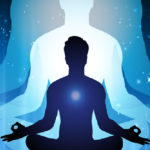Introduction if you have missed Part 1:
Recently I was thinking about some close friends who are younger than I am, raising families, with busy lives in the world. I could appreciate that it might be quite some time before they would be able to sit a long retreat. So I started wondering if there was a way for people in those circumstances to integrate some kind of meditation technique into their daily activities that could really touch the transformative power of the practice. On longer retreats it’s easier to access meditative depths, but when we’re otherwise intensely engaged, it can be quite a challenge.
Session II: Breaking Identification with the Body
The second three minutes helps break through the very deep identification with the body. For this there are two exercises that could be alternated, or the time could be divided between them.
The friends I had in mind had both lost one parent recently, so the focus of one session is to reflect on anyone we know who has died. If we were with them during that process, what was happening as they were dying, during their last days? Or if we don’t have this personal experience, we can reflect on the great sweep of generations over time, that birth inevitably ends in death. Really try to take in the truth of the body dying, take in what our bodies are and what happens to them. This is something that will come to pass for us all.
The idea of this exercise is to reflect on dying in as vivid a way as possible, and to apply it to our partner, to our children, to our friends—seeing that this is what naturally happens to all of us. It isn’t morbid, but rather a way of keeping front and center the truth that we all die. This can serve as a powerful reminder that our body is not “self.” It is simply going through its own process. One day, it’s going to decay and die—that’s nature. It’s just how it is.
The other exercise for loosening identification with the body is carried out in motion. When I walk somewhere, for example, if I’m mindful and really feeling the body moving, I notice that I’m simply experiencing sensations in space— pressure, motion, lightness. That’s all that’s happening. There’s not the sense of a solid body, and certainly not the sense of an “I” that’s doing the walking.
When sensations in space are being known, through the act of walking or any other movement, we begin to get a sense of the body as a fluid energy field. This can be illuminating—it can free the mind from being caught in the notion of the solidity of the body.
These two approaches are a good way of weakening the identification with the body as being self.








